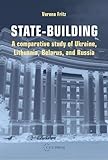State-building : A Comparative Study of Ukraine, Lithuania, Belarus, and Russia / Verena Fritz.
Material type: TextPublisher: Budapest ; New York : Central European University Press, [2007]Copyright date: 2007Description: 1 online resource (394 p.)Content type:
TextPublisher: Budapest ; New York : Central European University Press, [2007]Copyright date: 2007Description: 1 online resource (394 p.)Content type: - 9786155211126
- 320.947
- online - DeGruyter
| Item type | Current library | Call number | URL | Status | Notes | Barcode | |
|---|---|---|---|---|---|---|---|
 eBook
eBook
|
Biblioteca "Angelicum" Pont. Univ. S.Tommaso d'Aquino Nuvola online | online - DeGruyter (Browse shelf(Opens below)) | Online access | Not for loan (Accesso limitato) | Accesso per gli utenti autorizzati / Access for authorized users | (dgr)9786155211126 |
Browsing Biblioteca "Angelicum" Pont. Univ. S.Tommaso d'Aquino shelves, Shelving location: Nuvola online Close shelf browser (Hides shelf browser)

|

|

|

|

|

|

|
||
| online - DeGruyter The Anti-American Century / | online - DeGruyter Exploring the World of Human Practice : Readings in and about the Philosophy of Aurel Kolnai / | online - DeGruyter From Liberal Values to Democratic Transition : Essays in Honor of Janos Kis / | online - DeGruyter State-building : A Comparative Study of Ukraine, Lithuania, Belarus, and Russia / | online - DeGruyter New Jewish Identities / | online - DeGruyter Imperial Rule / | online - DeGruyter From Solidarity to Martial Law : The Polish Crisis of 1980–1981 / |
Frontmatter -- Table of Contents -- Abbrevations -- List of Tables and graphs -- Acknowledgements -- Introduction -- Chapter 1. State- and institution-building – a framework for analysis -- Chapter 2. A framework for assessing states: size, capacity, and quality -- Chapter 3. The dynamic of change: state-building as institution-building -- Chapter 4. A model of post-Soviet state-building trajectories -- Chapter 5. State-building in the post-Soviet region -- Chapter 6. Ukraine—from Soviet breakdown to disordered independence -- Chapter 7. A new trajectory taking shape -- Chapter 8. The second transition in Ukraine -- Chapter 9. Averting institutional change: the case of Belarus -- Chapter 10. Lithuania: moving towards Western models -- Chapter 11. The ‘authoritarianizing’ route to recovery: the case of Russian tax reform -- Chapter 12. Conclusion -- Appendix -- Bibliography -- Index
restricted access online access with authorization star
http://purl.org/coar/access_right/c_16ec
Looks at the process of state-building in Ukraine, Lithuania, Belarus, and Russia from a political economy and institutional perspective. Weak and distorted state capacity has come to be widely recognized as a key obstacle to successful transformation—including economic modernization and growth as well as the consolidation of democracy. However, so far little systematic research has been carried out on state capacity per se and on how to explain its development. The book provides new insights in considering the evolution of Ukraine since 1992, offering an in-depth view of institutional development in crucial areas and thus tracing the process of state-building. It draws comparisons with developments in Belarus, Lithuania, and Russia (based on field research). To capture the process of state-building empirically, focuses on the extraction and expenditure systems which are a central pillar of state capacity and also a central link between citizens and the state. The book also sheds light on how Ukraine’s potential ‘second transition’ currently under way will have an impact on its institutional system.
Mode of access: Internet via World Wide Web.
In English.
Description based on online resource; title from PDF title page (publisher's Web site, viewed 20. Nov 2024)


